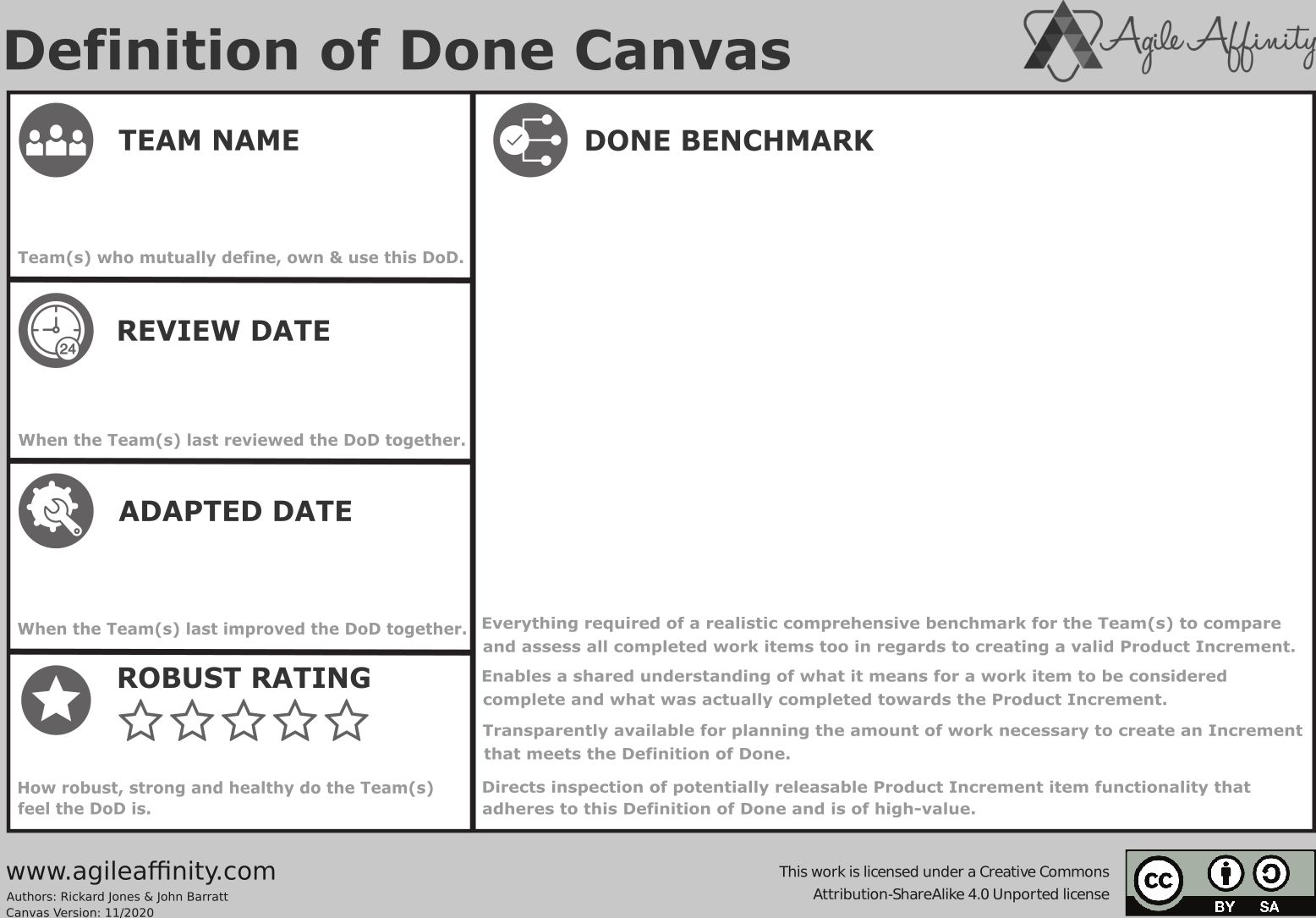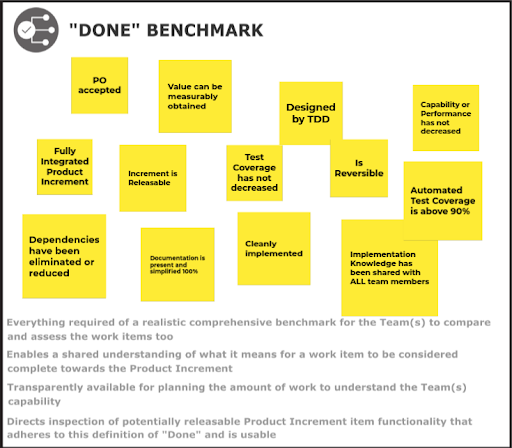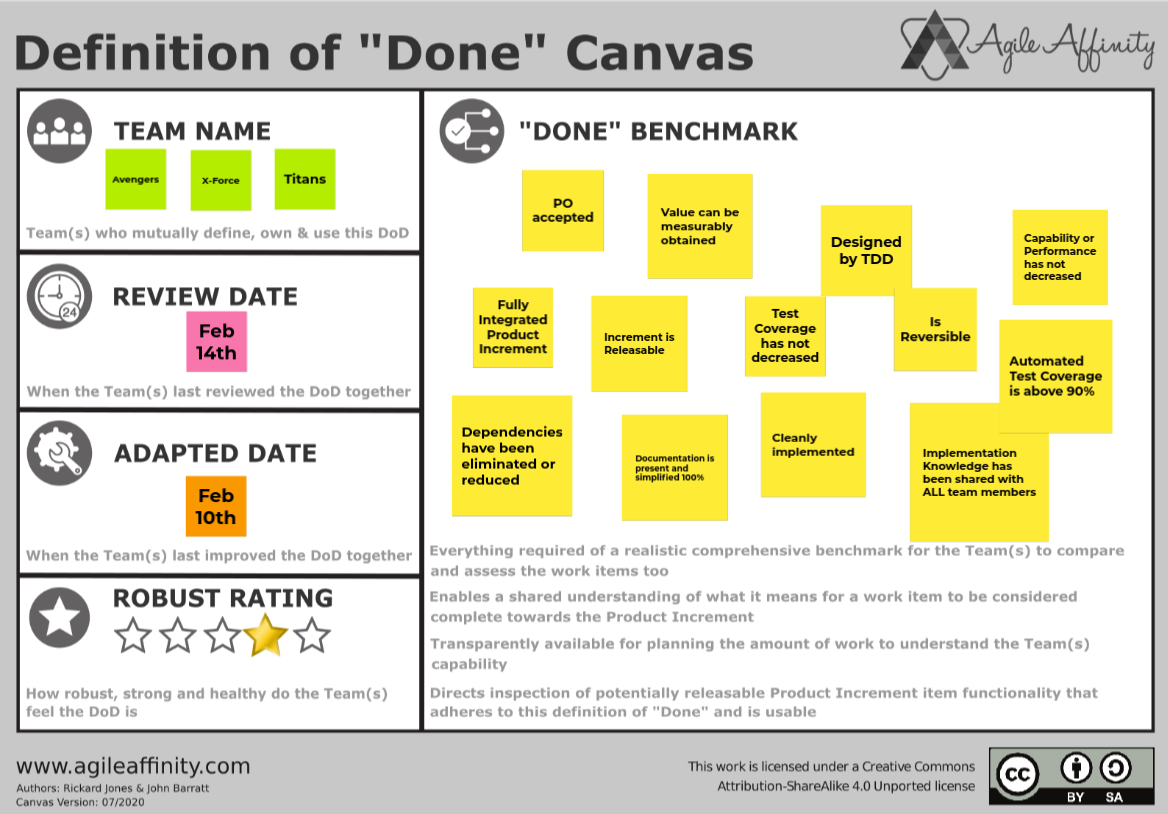Definition of Done Canvas
This article has been updated since the Scrum Guide 2020 was released soon after
Join the DZone community and get the full member experience.
Join For FreeUPDATED 11/2020:
This article and the DoD Canvas have been updated to reflect the Scrum Guide 2020. In the DoD Canvas, this includes removing the speech marks from the word Done and enriching some of the wording in the Benchmark section.
This has created a new version of the Canvas 11/2020. However, the essence of it remains the same though.
In the new version of the Scrum Guide [1] the Definition of Done (DoD) will move from enabling artifact transparency to becoming a commitment to a primary artifact of the Increment in its own right.
This leads us to the article I presented on the transparency concept of MuHinShu, where the outcome is the “information to flow associatively, as in a semi-lattice.” [2]
As the Scrum Guide states …
“The Definition of Done creates transparency by providing everyone a shared understanding of what work was completed as part of the Increment.".[3]
Therefore to support the catalyzation in this flow of information transparency here I present a “Definition of Done Canvas” tool [4] that Scrum teams can leverage for their empirical process control:

The canvas is freely available under the open-source Creative Commons license [5] so that you too can use this with any of your Scrum teams.
Why a DoD Canvas?
The original canvas I believe was called the “Business Model Canvas” developed by Alexander Osterwalder in his blog in 2008 [6]. Here he states that the canvas is a way of describing this as a ...
“business model is nothing else than a representation of how an organization makes (or intends to make) money.”
And a crude rudimentary Internet search shows us that there seems to be no evidence of an existing DoD canvas. Albeit the search was rudimentary so, please feel free to share it.
Therefore I have created a new one for the DoD so that Scrum teams can leverage this Canvas to represent their Definition of Done as a commitment to transparency. If it is not of value then hopefully it will provoke some thoughts on how you would like to represent your DoD even if you don’t use this Canvas.
A DoD Canvas is suitable for this purpose as it allows the Team(s) to dynamically represent this commitment because ...
“The Definition of Done is a formal description of the state of the Increment when it meets the quality measures required for the product.” [3].
As the DoD is dynamic and is expected to change, therefore a DoD Canvas is a suitable way of enabling maturity towards new definitions as it is as simple as changing the stickies upon the canvas without affecting the rest of the DoD.
It should be noted that the Canvas supports multiple teams working upon the same Product. As per the Scrum Guide …
“If there are multiple Scrum Teams working together on a product, they must mutually define and comply with the same Definition of Done.” [1].
Let’s take a look at the sections on this DoD Canvas to understand how they could possibly be used for your Scrum teams ...
TEAM NAME:

To make it visible we need to know which Development Team owns this DoD. And also enable multiple teams to own the DoD as above. This helps to make it clear that only they should be the ones who define and change this DoD.
REVIEW DATE:

“For each selected Product Backlog item, the Developers plan the work necessary to create an Increment that meets the Definition of Done.” [1]
From the statement in the Scrum Guide, we can observe that Scrum teams should look at the DoD even at the start of the Sprint in Planning. Otherwise, they may not be sure that they can deliver the work items and a product increment as Done.
In addition, this may not be the only time they review their DoD as teams. A team member or ScrumMaster here might want to point out to the teams during a Sprint if they have not reviewed the DoD together for a while.
ADAPTED DATE:

“Instilling quality by adhering to a Definition of Done;” [1].
We can observe here that the DoD is an evolving entity. Though anyone can see the DoD during a Sprint, it is good to know when the team(s) have adapted it together and when that last happened, which can be anytime as insights and learnings are discovered.
If a team member or ScrumMaster notices that the ADAPTED DATE has not changed in a while this can be a sign that the teams may not be maturing. Here the Scrum Guide can provide some help too ...
“The Scrum Team inspects how the last Sprint went with regards to individuals, interactions, processes, tools, and their Definition of Done." [7].
It should be noted that this is an option, one can adapt the DoD at any time and should not be a process of following Scrum for the sake of it. This anti-pattern is sometimes known as Zombie Scrum [8].
DONE BENCHMARK:

“The Definition of Done creates transparency by providing everyone a shared understanding of what work was completed as part of the Increment.” [3].
I have used the word Benchmark [9] as a way for the teams to compare work items and product increments to the DoD, rather than using the word as a way of comparing the performance of the teams. This is never the intention. I feel this should be explicitly stated so the term is not lost in Semantic Diffusion [10].
ROBUST RATING:

I often feel that people tend to get lost in the process of creating a DoD rather than following the first and foremost Agile Manifesto value of …
“Individuals and interactions over processes and tools” [11].
So, to promote this in the Canvas I would like to see how the team “feels” about their DoD. Do they feel they have great confidence in it? Is it strong and healthy? Maybe over time, the robustness rating they feel about it goes up or down? What does this show us?
A savvy ScrumMaster can also leverage this for ...
“Leading, training, and coaching the organization in its Scrum adoption;” [12].

Summary
For tangible usage, the DoD Canvas could be placed in online tools such as Mural, Miro, Jamboard, MS Teams etc to be used virtually for distributed teams.
Or printed out and placed upon a wall with real stickies, for those teams fortunate enough to be co-located in the same physical open space.
With the DoD Canvas in alignment to the Scrum Framework, we can observe that Scrum Teams can use this to transparently inspect and adapt their DoD. As they continuously improve their understanding of what it means to be “Done” for them, their work and how they feel about it.
With Special Thanks
To those referenced below and especially John Barratt for helping me to define this way of working at Agile Affinity [13], and contributing to this article. If you would like to talk in more detail on the topic email us on or even better comment below!
References
- Scrum Guide - by Ken Schwaber and Jeff Sutherland 2017
- Agile Coaching With MuHinShu - by Rickard Jones & John Barratt 2019
- Scrum Guide - Scrum Artifact Increment - by Ken Schwaber and Jeff Sutherland 2017
- DoD Canvas PDF - by Rickard Jones & John Barratt 2020
- Creative Commons - from 2001
- Business Model Canvas - by Alex Osterwalder 2008
- Scrum Guide - Sprint Retrospective - by Ken Schwaber and Jeff Sutherland 2017
- Zombie Scrum Teams! - by Daniel Mezick 2010
- Benchmark definition
- Semantic Diffusion - by Martin Fowler 2006
- Manifesto for Agile Software Development by Kent Beck et al 2001
- Scrum Guide - ScrumMaster - by Ken Schwaber and Jeff Sutherland 2017
- Agile Affinity - by Rickard Jones & John Barratt 2019
Opinions expressed by DZone contributors are their own.

Comments